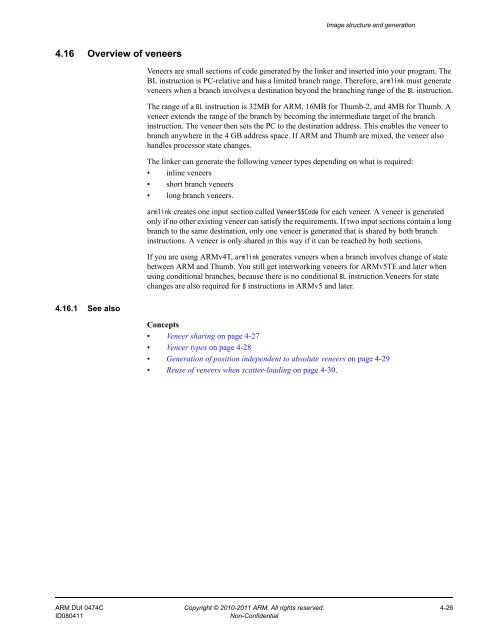ARM Compiler toolchain Using the Linker - ARM Information Center
ARM Compiler toolchain Using the Linker - ARM Information Center
ARM Compiler toolchain Using the Linker - ARM Information Center
Create successful ePaper yourself
Turn your PDF publications into a flip-book with our unique Google optimized e-Paper software.
4.16 Overview of veneers<br />
4.16.1 See also<br />
Image structure and generation<br />
Veneers are small sections of code generated by <strong>the</strong> linker and inserted into your program. The<br />
BL instruction is PC-relative and has a limited branch range. Therefore, armlink must generate<br />
veneers when a branch involves a destination beyond <strong>the</strong> branching range of <strong>the</strong> BL instruction.<br />
The range of a BL instruction is 32MB for <strong>ARM</strong>, 16MB for Thumb-2, and 4MB for Thumb. A<br />
veneer extends <strong>the</strong> range of <strong>the</strong> branch by becoming <strong>the</strong> intermediate target of <strong>the</strong> branch<br />
instruction. The veneer <strong>the</strong>n sets <strong>the</strong> PC to <strong>the</strong> destination address. This enables <strong>the</strong> veneer to<br />
branch anywhere in <strong>the</strong> 4 GB address space. If <strong>ARM</strong> and Thumb are mixed, <strong>the</strong> veneer also<br />
handles processor state changes.<br />
The linker can generate <strong>the</strong> following veneer types depending on what is required:<br />
• inline veneers<br />
• short branch veneers<br />
• long branch veneers.<br />
armlink creates one input section called Veneer$$Code for each veneer. A veneer is generated<br />
only if no o<strong>the</strong>r existing veneer can satisfy <strong>the</strong> requirements. If two input sections contain a long<br />
branch to <strong>the</strong> same destination, only one veneer is generated that is shared by both branch<br />
instructions. A veneer is only shared in this way if it can be reached by both sections.<br />
If you are using <strong>ARM</strong>v4T, armlink generates veneers when a branch involves change of state<br />
between <strong>ARM</strong> and Thumb. You still get interworking veneers for <strong>ARM</strong>v5TE and later when<br />
using conditional branches, because <strong>the</strong>re is no conditional BL instruction.Veneers for state<br />
changes are also required for B instructions in <strong>ARM</strong>v5 and later.<br />
Concepts<br />
• Veneer sharing on page 4-27<br />
• Veneer types on page 4-28<br />
• Generation of position independent to absolute veneers on page 4-29<br />
• Reuse of veneers when scatter-loading on page 4-30.<br />
<strong>ARM</strong> DUI 0474C Copyright © 2010-2011 <strong>ARM</strong>. All rights reserved. 4-26<br />
ID080411 Non-Confidential

















